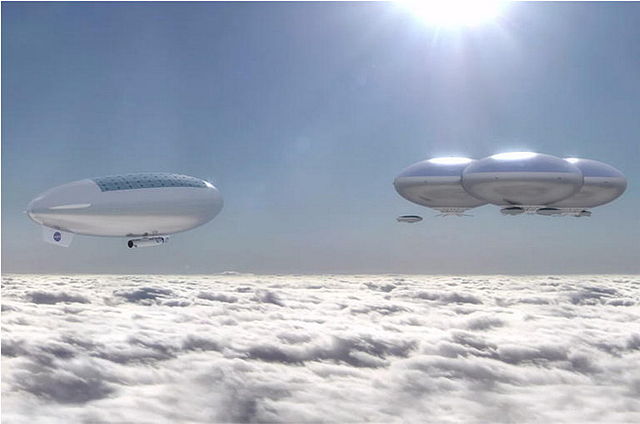High Altitude Venus Operational Concept
High Altitude Venus Operational Concept (HAVOC) is a set of crewed NASA mission concepts to the planet Venus. All human portions of the missions would be conducted from lighter-than-air craft or from orbit. A similar concept, the "Floating Islands of Venus", was proposed by Soviet engineer and sci-fi writer Sergei Zhitomirsky in 1971.
Artist's rendering of a NASA crewed floating outpost on Venus
Suggested specifications for the robotic airship
Slide detailing sequence of events for the crewed descent
The atmosphere of Venus is the very dense layer of gasses surrounding the planet Venus. Venus's atmosphere is composed of 96.5% carbon dioxide and 3.5% nitrogen, with other chemical compounds present only in trace amounts. It is much denser and hotter than that of Earth; the temperature at the surface is 740 K, and the pressure is 93 bar (1,350 psi), roughly the pressure found 900 m (3,000 ft) under water on Earth. The atmosphere of Venus supports decks of opaque clouds of sulfuric acid that cover the entire planet, making optical Earth-based and orbital observation of the surface impossible. Information about surface topography has been obtained exclusively by radar imaging.
1761 drawing by Mikhail Lomonosov in his work on the discovery of atmosphere of Venus
Composite image of the polar vortex of Venus in strong red (red image is an infrared view of hot high clouds and the grey image is an ultra-violet view of lower clouds)
Meridional (north-south) component of the atmospheric circulation in the atmosphere of Venus. Note that the meridional circulation is much lower than the zonal circulation, which transports heat between the day and night sides of the planet
False colour near-infrared (2.3 μm) image of the deep atmosphere of Venus obtained by Galileo, red areas are signatures of the hot surface radiating through the atmosphere relatively unhindered. The dark spots are clouds silhouetted against the very hot lower atmosphere emitting thermal infrared radiation.







